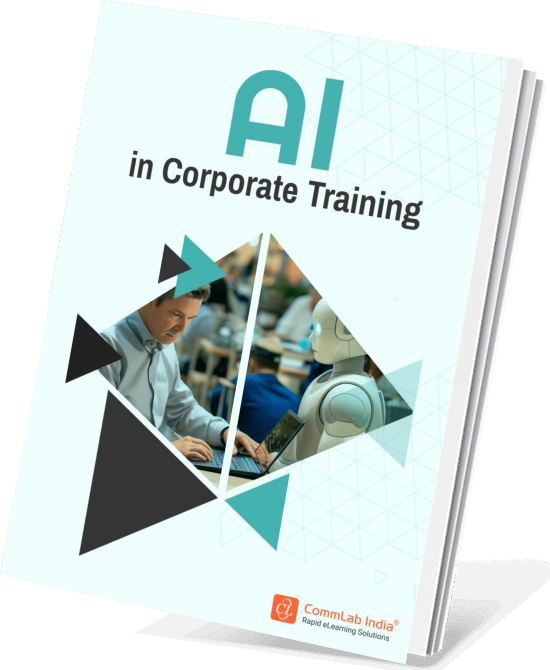The Ultimate Guide on Effective Hybrid Workforce Training

After the pandemic, companies have adopted a more flexible approach to their working structure. Gone are the days when work meant employees attending to the tasks from their designated cubicles from a single office location, every day. With the rise in technology and the wake of work-life balance, the idea of a hybrid workforce is gaining popularity. This flexible structure offers numerous benefits for both employees and the employer. In this blog, we will explore the concept of a hybrid workforce, the challenges associated with training the hybrid workforce, effective training solutions, and a range of strategies to facilitate effective hybrid learning. So without any delay, let’s start!
→ Download eBook: AI in Corporate Training
Table of Contents
- What Is a Hybrid Workforce?
- What Are the Challenges in Training a Hybrid Workforce?
- What Are the Effective Training Solutions for a Hybrid Workforce?
- What Is Hybrid Learning?
- What Are the Benefits of Hybrid Learning for Both Employees and Employers?
- What Should Be the Vision for a Hybrid Learning Plan for a Hybrid Workforce?
- What Are the Key Considerations When Developing Hybrid Learning Programs?
What Is a Hybrid Workforce?
A hybrid workforce is a concept where some employees of the organization work remotely and some work on-site. This fosters flexibility and convenience allowing organizations to gain access to a diverse and wider talent pool irrespective of location barriers. Apart from this, the hybrid approach allows for increased work-life balance and improved employee satisfaction.
What Are the Challenges in Training a Hybrid Workforce?
While the hybrid model offers significant advantages, it also presents distinct challenges when it comes to training and development. Here are some of the key hurdles to overcome.

Let’s understand more about each challenge in detail.
Accessibility
Ensuring all training materials and activities are accessible to both in-person and remote learners can be difficult. Traditional instructor-led training sessions can exclude remote employees. On the other hand, relying solely on online learning can leave in-person participants feeling anxious about having to manage both work and training during office hours.
Ensuring Learner Engagement
Maintaining a high level of learner engagement for both remote and in-office employees during training sessions requires specialized techniques. Remote participants can easily become distracted, while learners present in the training room might feel disengaged if the training is not interactive or caters solely to the online audience.
Technology Integration
Effectively integrating technology into the training process is crucial, but it can be complex. Choosing the right platform, ensuring everyone has the necessary equipment, and troubleshooting technical issues isn’t as easy as it might seem to be. In fact, not being able to manage these things properly can often hinder the learning experience and negatively impact the training ROI.

Understanding AI in Corporate Training
Revolutionize Your Training with Next-Level Learning
- How AI enhances existing training programs
- AI toolkit for design and development
- Challenges to Consider with AI Implementation
- And More!
What Are the Effective Training Solutions for a Hybrid Workforce?
Hey! Are You Facing Issues While Training Your Hybrid Workforce?
Here are 4 effective training solutions to help you:
- Minimization of on-site training
- Inclusion of immersive and experimental learning opportunities
- Introduction to Metaverse
- Implementation of collaborations and informal learning
1. Minimization of On-site Training
This might sound a bit odd and highly debatable but consider it from a global point of view. What is the most common characteristic of a hybrid workforce? It appeals to the global audience. When a company decides to continue the approach of on-site training and prefers it over online training, the whole narrative of a hybrid workforce is deemed to be irrelevant.
To enhance productivity within a hybrid workplace, training of the hybrid workforce should be switched from traditional on-site programs into online eLearning solutions. Employees living anywhere in the world can be trained properly and effectively if the approach itself is shifted towards remote learning.
2. Inclusion of Immersive and Experiential Learning Opportunities
Try to make the learning experiences experiential, immersive, and engaging for the hybrid workforce. This can be done through several techniques.

Every technique has to be properly crafted to increase the learner engagement while also maintaining the optimum level of knowledge transfer. Such immersive and experiential learning techniques will help the employees in a hybrid workforce to understand different points of view and explore potential errors and malpractices with their best-suited solutions.
3. Introduction to Metaverse
Metaverse is an advanced stage to basic implementation of Augmented Reality (AR) and Virtual Reality (VR) in your training programs. Metaverse is basically a whole new universe where your internet self is considered an individual entity. To put it in simple words, metaverse refers to an integrated network of 3D virtual worlds.
Users access the metaverse through VR headsets and navigate using their eye movements, air gestures, controllers, voice commands, and other sensory technologies. Metaverse creates a sensation of physical presence in a virtual environment.
Now consider all the characteristics of the metaverse and assume your office or workplace is embedded in a metaverse. You can practically attend your office, interact with other employees and take part in other on-site activities while staying in your bedroom. If I keep going about the metaverse, the base context will deviate so let’s conclude with the fact that the future of a hybrid workforce lies within the metaverse.
4. Leveraging Platforms for Collaborations and Informal Learning
The collaborative learning approach within a hybrid workforce enhances communication among employees and helps them to develop an informal work relationship with each other. Collaborations lead to improved adaptability among teams and the respective individuals working either on-site or remote.
Practices such as discussions and debates along with surveys can promote the concept of social interactions that will eventually provide the best results for a hybrid workforce. Different teams within an organization can collaborate virtually over calls, meetings, or a webinar to deliver a project that would help them to know each other across the globe and work accordingly.
Modern technologies support a remote collaborative approach toward hybrid workforce training and harnessing new tools and technologies will only ease the overall process.
All these solutions can be termed under a common category: hybrid learning! Let’s learn more about it in detail.

Understanding AI in Corporate Training
Revolutionize Your Training with Next-Level Learning
- How AI enhances existing training programs
- AI toolkit for design and development
- Challenges to Consider with AI Implementation
- And More!
What Is Hybrid Learning?
Hybrid learning is a blended approach to corporate training that combines both online and in-person instruction. It offers a mix of self-paced online modules as well as interactive face-to-face sessions with instructors. This combination allows for a more personalized and engaging learning experience for employees.
What Are the Benefits of Hybrid Learning for Both Employees and Employers?

1. Flexibility and Accessibility: Hybrid learning allows personalized eLearning experiences, offering flexibility for continuous learning.
2. Cost-Effective Training: Employers save costs with scalable, easy to update methods like eLearning and microlearning. This reduces the dependance on physical resources and also minimizes the cost associated with them.
3. Improved Knowledge Retention: Hybrid learning is a great way to make sure your learners remember all those important facts and figures! It's a personalized and engaging approach that enables the learners to learn at their own pace, access different learning materials, and take part in fun, interactive activities. This multi-faceted exposure to information helps them learn and understand things better.
4. Adaptability to Learning Styles: Hybrid learning accommodates diverse styles, integrating multimedia, eLearning interactivities, and relevant eLearning assessments.
5. Enhanced Employee Engagement: Personalized learning paths increase learner engagement by making content relevant to individual roles.
6. Real-time Performance Tracking: Learner-centric assessments and Learning Management Systems (LMS) enable real-time monitoring and tailored learning experiences.
7. Scalability of Training Programs: Hybrid learning allows scalable deployment of updated eLearning content to a large audience.
8. Support for Remote Collaboration: Tools for collaborative learning facilitate remote teamwork and enable knowledge sharing.
9. Continuous Learning Culture: Hybrid learning nurtures a culture of continuous learning, empowering employees for ongoing professional development.
In a nutshell, hybrid learning delivers flexibility, cost savings, scalability, enhanced training, and improved retention – factors crucial for companies to stay competitive in the evolving work landscape.

Understanding AI in Corporate Training
Revolutionize Your Training with Next-Level Learning
- How AI enhances existing training programs
- AI toolkit for design and development
- Challenges to Consider with AI Implementation
- And More!
What Should Be the Vision for a Hybrid Learning Plan for a Hybrid Workforce?
- Create a learning plan that accommodates both remote and in-person work setups, allowing employees to access training regardless of their location.
- Combine real-time sessions with self-paced modules to cater to the diverse learning preferences and schedules of a hybrid workforce.
- Incorporate virtual collaboration tools and platforms to facilitate interaction and teamwork among remote and on-site employees during training sessions.
- Design learning materials and platforms that are accessible to all employees, including those with disabilities or limited internet connectivity.
- Utilize interactive elements, gamification, microlearning modules, and multimedia content to keep learners engaged and motivated throughout the training process.
- Offer ongoing support and resources to help employees navigate the challenges of hybrid learning environments effectively.
What Are the Key Considerations When Developing Hybrid Learning Programs?

1. Leverage Robust eLearning Authoring Tools
Leverage the capabilities of leading eLearning authoring tools like iSpring and Articulate. These tools boast interactive features, such as user-friendly drag-and-drop functionality, streamlining course creation. The result is a dynamic, engaging learning experience for your hybrid workforce, enhancing employee engagement and knowledge retention.

2. Integrate Engaging eLearning Templates
Enhance the visual appeal of eLearning modules by incorporating captivating templates. For instance, integrate gamified eLearning templates to elevate learner engagement and retention. This strategic use of templates not only adds aesthetic value but also contributes to a dynamic learning environment, fostering active participation and knowledge retention among your hybrid workforce.
3. Prioritize Personalized Learning Paths
Adopt adaptive learning strategies to customize eLearning content according to individual learner preferences and performance. For instance, incorporate branching scenarios within eLearning modules, providing personalized learning journeys. This approach ensures a tailored educational experience, catering to diverse learning needs and optimizing engagement for each member of your hybrid workforce.

4. Utilize Learning Analytics for Continuous Improvement
Optimize employee performance and engagement by harnessing learning analytics within the Learning Management System (LMS). Regularly reviewing analytics data allows for the identification of trends, gaps, and areas for improvement in eLearning content. This data-driven approach ensures continuous enhancement of courses, maximizing the effectiveness of your hybrid workforce's learning experience.
5. Enhance Employee Engagement Through Multimedia
Elevate eLearning engagement by seamlessly integrating multimedia elements like videos, simulations, and podcasts. Employ scenario-based videos to immerse learners in real-world situations, fostering active participation. This multimedia-rich approach enhances the overall eLearning experience, ensuring that your hybrid workforce remains captivated and gains practical insights essential for their roles.

6. Implement Microlearning Modules for Quick Consumption
Enhance learning efficiency by crafting bite-sized eLearning modules that cater to quick consumption and optimal retention. Break down intricate subjects into focused microlearning sessions, ensuring efficient knowledge transfer for your hybrid workforce. This approach promotes seamless learning experiences, allowing employees to grasp key concepts swiftly and apply them effectively in their roles.
Why Microlearning is Ideal for Corporate Training [Watch Video]
7. Encourage Collaborative Learning with Social eLearning Features
Foster a sense of community and collaborative learning by incorporating social elements within eLearning platforms. Create opportunities for employees to engage through discussion forums or collaborative projects, encouraging knowledge sharing and teamwork. This inclusive approach enhances the overall learning experience, promoting a dynamic and interactive environment for your hybrid workforce.

8. Ensure Seamless Integration with the LMS
Optimize tracking and reporting efficiency by choosing eLearning tools that seamlessly integrate with your existing Learning Management System (LMS). Prioritize authoring tools that offer SCORM compatibility, ensuring a smooth connection for centralized monitoring. This streamlined approach enhances data accuracy and accessibility, facilitating effective evaluation of employee performance in your hybrid learning environment.

9. Continuous Monitoring and Adaptation
Maintain eLearning effectiveness through consistent monitoring of learning analytics. Regularly assess data to identify popular modules and areas that may need reinforcement, ensuring a proactive approach to optimizing your hybrid learning environment. Utilizing these insights enables timely adjustments, fostering continuous improvement in employee development and knowledge acquisition within your organization.
Implementing these considerations ensures the effectiveness of hybrid learning programs, contributing to the success of your L&D initiatives. Embrace adaptability, leverage technology, and create a learning environment that resonates with the needs of your hybrid workforce.
Wrapping Up!
A hybrid workforce is an integral part of the corporate world and to keep the workforce engaged, multiple advancements have been made while a few are in development. Companies that are still hesitant to the idea of hybrid workforce are lacking way behind in terms of productivity, employee engagement, and an overall healthy working environment. Along with a hybrid workforce, there’s another thing gaining popularity in the business and corporate world. It’s Artificial Intelligence (AI)! It holds immense potential to revolutionize the way you train your hybrid workforce. Learn more about it in our latest eBook on AI in corporate training. Check it out below!
Editor’s note: This post was originally published on February 05, 2024 and has been updated for comprehensiveness.





